2003 AUDI A8 air condition
[x] Cancel search: air conditionPage 78 of 96

Downloaded from www.Manualslib.com manuals search engine 78
Electric rear additional heater
An electric rear additional heater is fitted
under each front seat in the rear climate
control footwell air ducts.
Heating/Air Conditioner
A further advantage is that independent
temperature regulation (heating) can be
provided for the rear footwell with the 4-zone
system.
A supply of colder air to the rear climate zones
as opposed to the front can be achieved by
way of the centre chest vents.
The temperature can however only be reduced
but not increased via these vents through the
addition of cold air.
As in the predecessor model, two separately
controlled heat exchangers permit the setting
of different temperatures at front left/right.
All occupants can therefore be provided with
individual climate control. Operation
Following a cold start or at low ambient
temperatures, there is insufficient waste heat
in the coolant to warm the rear of the vehicle
by means of a conventional fluid-filled heater.
In addition, the drop in temperature in the rear
air duct is extremely high in the initial phase.
This problem has been solved by integrating
two electric rear additional heaters into the
rear footwell air duct.
These employ electrical energy from the
vehicle electrical system to heat the air
supplied to the passenger compartment.
In this way, the heating function is available
immediately following cold starting.
As was the case with the predecessor
model, in situ heat exchanger
replacement is possible. The procedure
involved is described in the current
Workshop Manual.
SSP282_102
Page 80 of 96
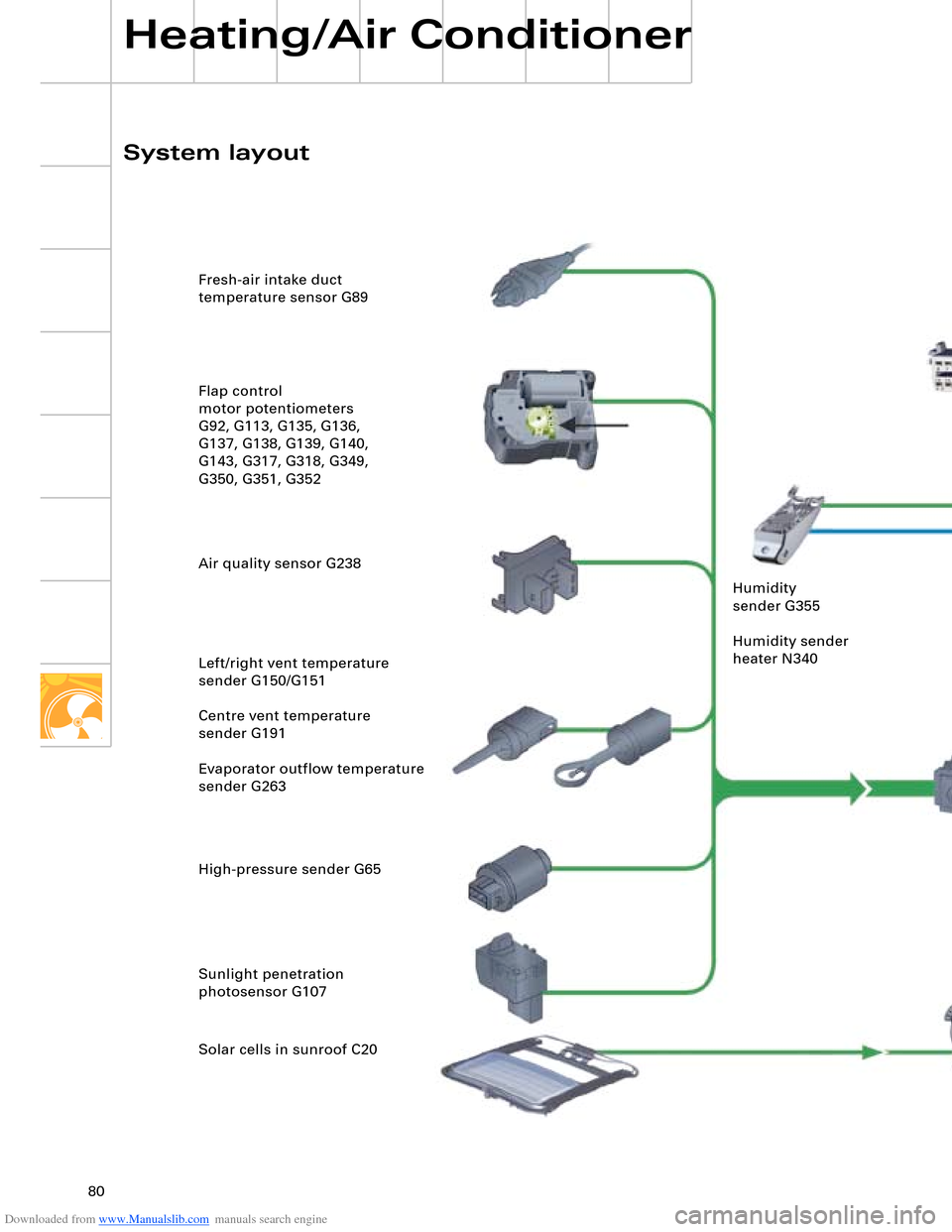
Downloaded from www.Manualslib.com manuals search engine 80
Heating/Air Conditioner
SSP282_103 Fresh-air intake duct
temperature sensor G89
Flap control
motor potentiometers
G92, G113, G135, G136,
G137, G138, G139, G140,
G143, G317, G318, G349,
G350, G351, G352
Air quality sensor G238
Left/right vent temperature
sender G150/G151
Centre vent temperature
sender G191
Evaporator outflow temperature
sender G263
High-pressure sender G65
Sunlight penetration
photosensor G107
Solar cells in sunroof C20
System layoutControl unit with display
in dash panel insert J285
MOST busFront information display and
operating unit control unit J523
Rear right footwell heater
element Z43 Rear left footwell heater
element Z42 Fresh-air blower control unit
J126 with fresh-air blower V2Diagnosis CAN
Data bus diagnostic
interface J533
Sunroof electronics
control unit J528 Humidity
sender G355
Humidity sender
heater N340
Climatronic
control unit J255
Convenience CAN
Additional heater
control unit J364 Rear Climatronic control
and display unit E265Energy management
control unit J644Drive system CANEngine control unit J623Front information and display and
operating unit control unit J685
Radiator fan
control unit J293
Radiator fan V7
Air conditioning system compressor regulating valve N280
Flap control motors
V68, V71, V102, V107, V108, V109,
V110, V111, V113, V199, V200, V220,
V218, V219, V221
Coolant circulation pump V50
Left/right heat regulation valve N175/N176
Heated windscreen control unit J505
Heated windscreen Z2
Driver seat/front passenger seat ventilation control unit
J672/J673
Front left/front right heated seat Z45/Z46
Temperature sender for front left/front right seat
G344/G345
Page 81 of 96
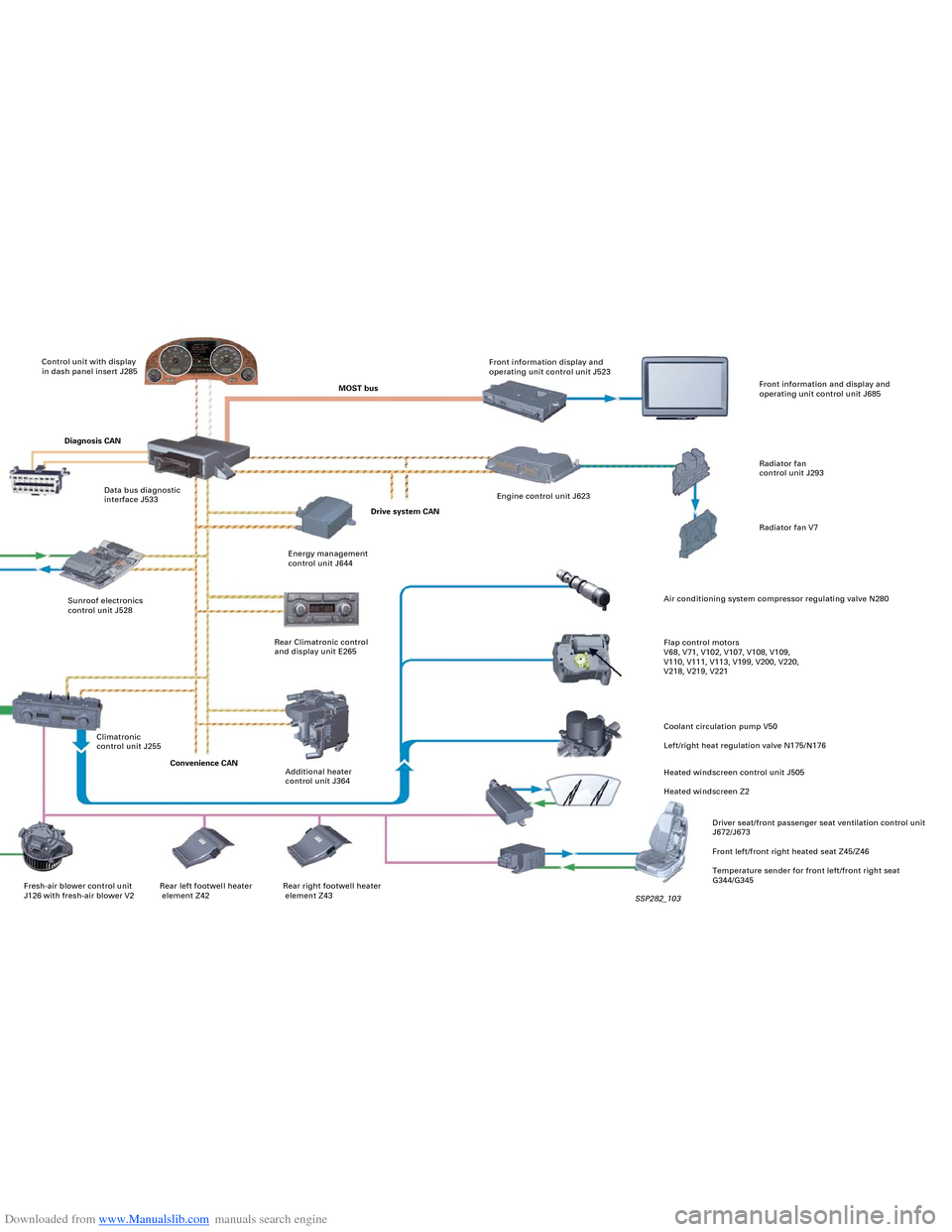
Downloaded from www.Manualslib.com manuals search engine 80
Heating/Air Conditioner
SSP282_103 Fresh-air intake duct
temperature sensor G89
Flap control
motor potentiometers
G92, G113, G135, G136,
G137, G138, G139, G140,
G143, G317, G318, G349,
G350, G351, G352
Air quality sensor G238
Left/right vent temperature
sender G150/G151
Centre vent temperature
sender G191
Evaporator outflow temperature
sender G263
High-pressure sender G65
Sunlight penetration
photosensor G107
Solar cells in sunroof C20
System layoutControl unit with display
in dash panel insert J285
MOST busFront information display and
operating unit control unit J523
Rear right footwell heater
element Z43 Rear left footwell heater
element Z42 Fresh-air blower control unit
J126 with fresh-air blower V2Diagnosis CAN
Data bus diagnostic
interface J533
Sunroof electronics
control unit J528 Humidity
sender G355
Humidity sender
heater N340
Climatronic
control unit J255
Convenience CAN
Additional heater
control unit J364 Rear Climatronic control
and display unit E265Energy management
control unit J644Drive system CANEngine control unit J623Front information and display and
operating unit control unit J685
Radiator fan
control unit J293
Radiator fan V7
Air conditioning system compressor regulating valve N280
Flap control motors
V68, V71, V102, V107, V108, V109,
V110, V111, V113, V199, V200, V220,
V218, V219, V221
Coolant circulation pump V50
Left/right heat regulation valve N175/N176
Heated windscreen control unit J505
Heated windscreen Z2
Driver seat/front passenger seat ventilation control unit
J672/J673
Front left/front right heated seat Z45/Z46
Temperature sender for front left/front right seat
G344/G345
Page 82 of 96
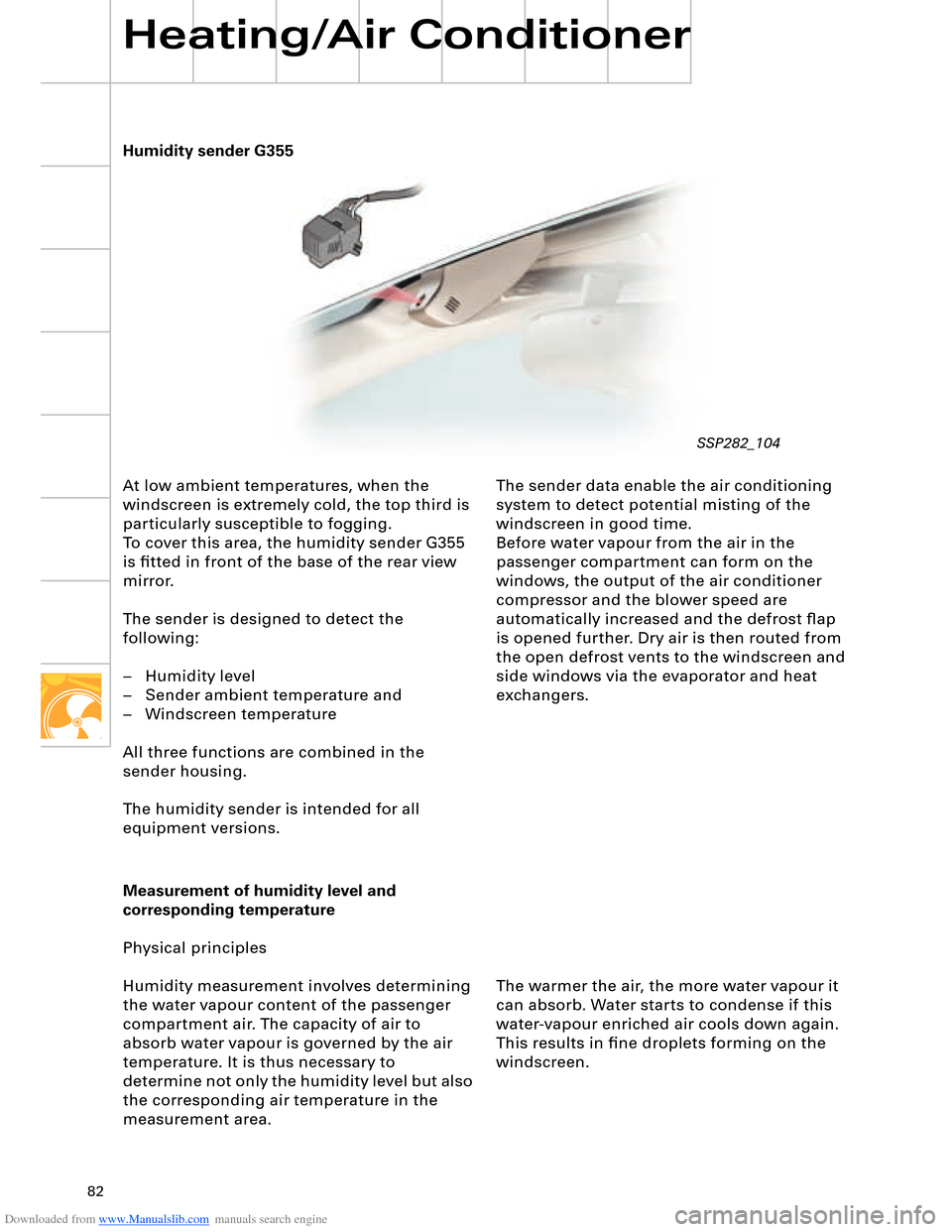
Downloaded from www.Manualslib.com manuals search engine 82
Humidity sender G355
Heating/Air Conditioner
At low ambient temperatures, when the
windscreen is extremely cold, the top third is
particularly susceptible to fogging.
To cover this area, the humidity sender G355
is fitted in front of the base of the rear view
mirror.
The sender is designed to detect the
following:
– Humidity level
– Sender ambient temperature and
– Windscreen temperature
All three functions are combined in the
sender housing.
The humidity sender is intended for all
equipment versions.The sender data enable the air conditioning
system to detect potential misting of the
windscreen in good time.
Before water vapour from the air in the
passenger compartment can form on the
windows, the output of the air conditioner
compressor and the blower speed are
automatically increased and the defrost flap
is opened further. Dry air is then routed from
the open defrost vents to the windscreen and
side windows via the evaporator and heat
exchangers.
Measurement of humidity level and
corresponding temperature
Physical principles
Humidity measurement involves determining
the water vapour content of the passenger
compartment air. The capacity of air to
absorb water vapour is governed by the air
temperature. It is thus necessary to
determine not only the humidity level but also
the corresponding air temperature in the
measurement area.The warmer the air, the more water vapour it
can absorb. Water starts to condense if this
water-vapour enriched air cools down again.
This results in fine droplets forming on the
windscreen.
SSP282_104
Page 84 of 96
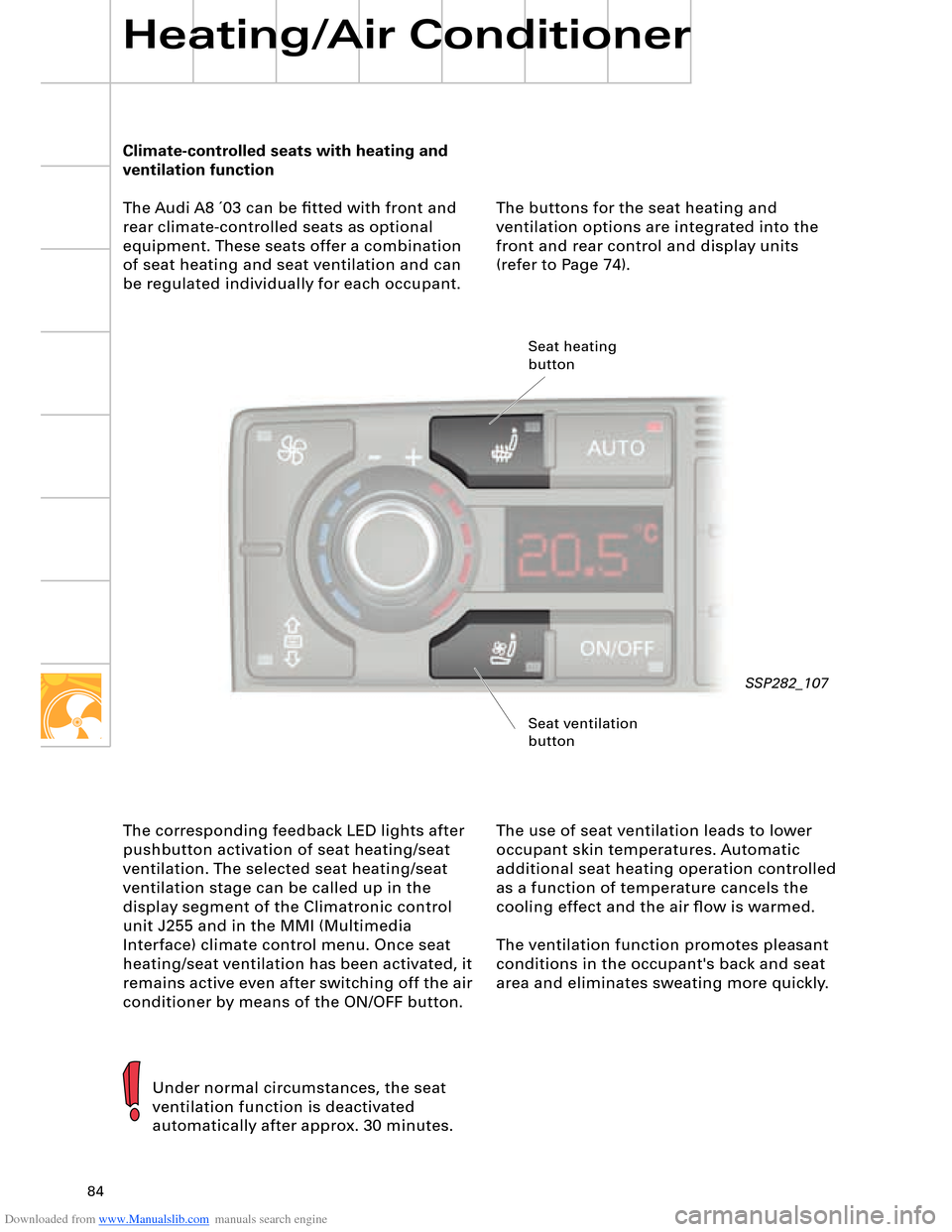
Downloaded from www.Manualslib.com manuals search engine 84
The buttons for the seat heating and
ventilation options are integrated into the
front and rear control and display units
(refer to Page 74). Climate-controlled seats with heating and
ventilation function
The Audi A8 ´03 can be fitted with front and
rear climate-controlled seats as optional
equipment. These seats offer a combination
of seat heating and seat ventilation and can
be regulated individually for each occupant.
Heating/Air Conditioner
The corresponding feedback LED lights after
pushbutton activation of seat heating/seat
ventilation. The selected seat heating/seat
ventilation stage can be called up in the
display segment of the Climatronic control
unit J255 and in the MMI (Multimedia
Interface) climate control menu. Once seat
heating/seat ventilation has been activated, it
remains active even after switching off the air
conditioner by means of the ON/OFF button.The use of seat ventilation leads to lower
occupant skin temperatures. Automatic
additional seat heating operation controlled
as a function of temperature cancels the
cooling effect and the air flow is warmed.
The ventilation function promotes pleasant
conditions in the occupant's back and seat
area and eliminates sweating more quickly.
Under normal circumstances, the seat
ventilation function is deactivated
automatically after approx. 30 minutes.
SSP282_107 Seat heating
button
Seat ventilation
button
Page 86 of 96

Downloaded from www.Manualslib.com manuals search engine 86
J126 Fresh-air blower control unit
J255 Climatronic control unit
J528 Sunroof electronics control unit
J533 Data bus diagnostic interface
N175 Left heat regulation valve
N176 Right heat regulation valve
N280 Air conditioning system compressor
regulating valve
N340 Humidity sender heater
T16 16-pin connector
(diagnostic connection)
V2 Fresh-air blower
V42 Temperature sensor blower
V50 Coolant circulation pump
V68 Temperature flap control motor
V71 Air-flow flap control motor
V102 Central vent control motor
V107 Defroster flap control motor
V108 Left footwell flap control motor
V109 Right footwell flap control motor
V110 Left central vent control motor
V111 Right centre vent control motor
V113 Air-recirculation flap control motor
V199 Front right defroster/chest vent
shutoff flap control motor
V200 Front left defroster/chest vent
shutoff flap control motor
V220 Rear left vent warm/cold flap
control motor
V221 Rear right vent warm/cold flap
control motor
Z42 Rear left footwell heater element
Z43 Rear right footwell heater element
Z45 Front left heated seat
Z46 Front right heated seat
Block diagram for
front air conditioner
Key
C20 Solar cells
G56 Dash panel temperature sensor
G65 High-pressure sender
G89 Fresh-air intake duct temperature
sensor
G92 Temperature flap control motor
potentiometer
G107 Sunlight penetration photosensor
G113 Air-flow flap control motor
potentiometer
G135 Defrost flap control motor
potentiometer
G136 Left central vent control motor
potentiometer
G137 Right central vent control motor
potentiometer
G138 Central vent control motor
potentiometer
G139 Left footwell flap control motor
potentiometer
G140 Right footwell flap control motor
potentiometer
G143 Air recirculation flap control motor
potentiometer
G150 Left vent temperature sender
G151 Right vent temperature sender
G191 Centre vent temperature sender
G238 Air quality sensor
G263 Evaporator outflow temperature
sender
G317 Front right defroster/
chest vent shutoff flap
control motor potentiometer
G318 Front left defroster/
chest vent shutoff flap
control motor potentiometer
G344 Temperature sender for front left seat
G345 Temperature sender for front
right seat
G347 Centre left vent sensor
G348 Centre right vent sensor
G351 Rear left vent warm/cold
control motor potentiometer
G352 Rear right vent warm/cold
control motor potentiometer
G355 Humidity sender
Heating/Air Conditioner
Page 88 of 96
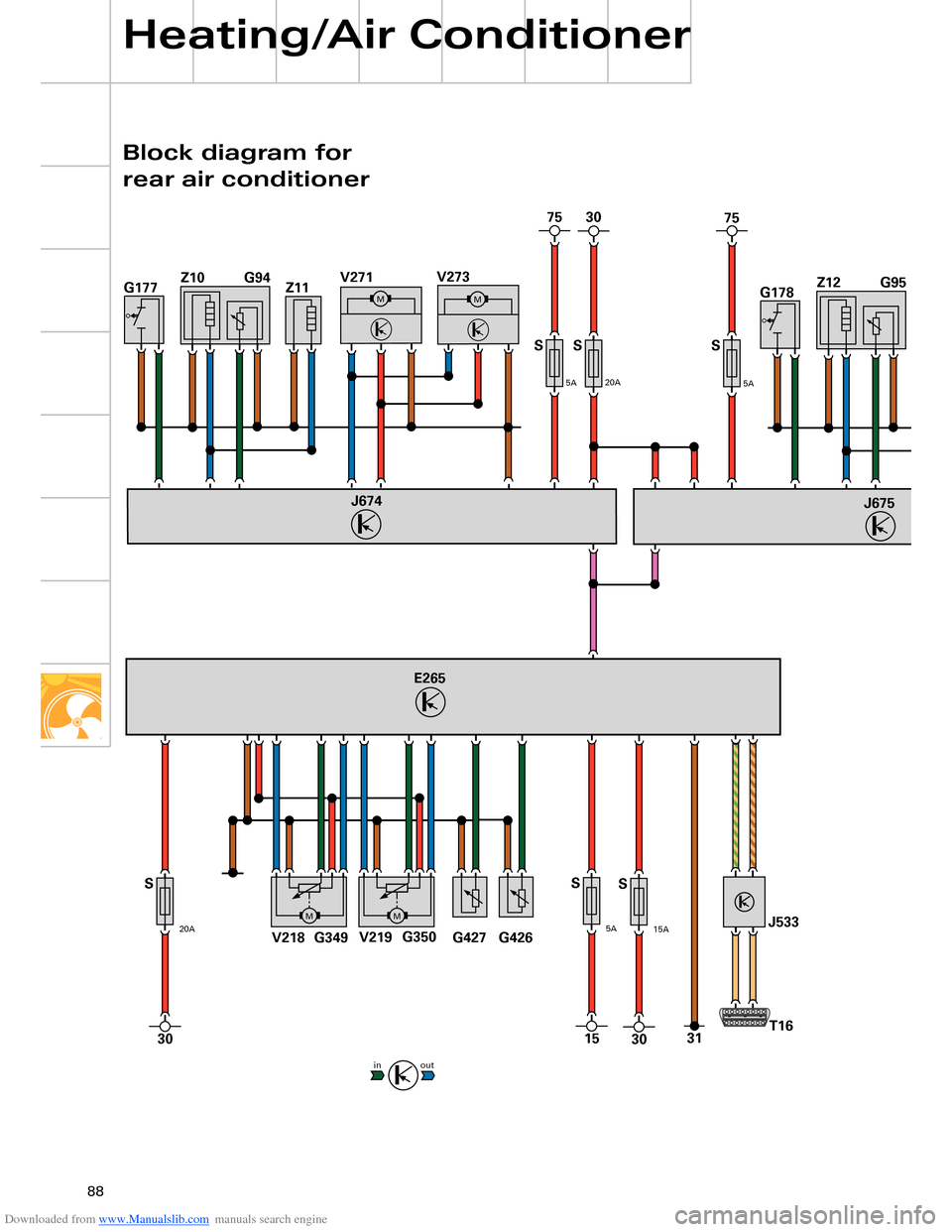
Downloaded from www.Manualslib.com manuals search engine 88
Z12
E265
S
20A
30
G178
31
in out
G426 G427 V219
G349G350
M
V218
MJ533
S
15A
30
S
5A
15
G95
S
5A
3075
S
20A
S
5A
75
Z11 Z10V273G177G94
MM
V271
J674
J675
T16
Heating/Air Conditioner
Block diagram for
rear air conditioner
Page 90 of 96
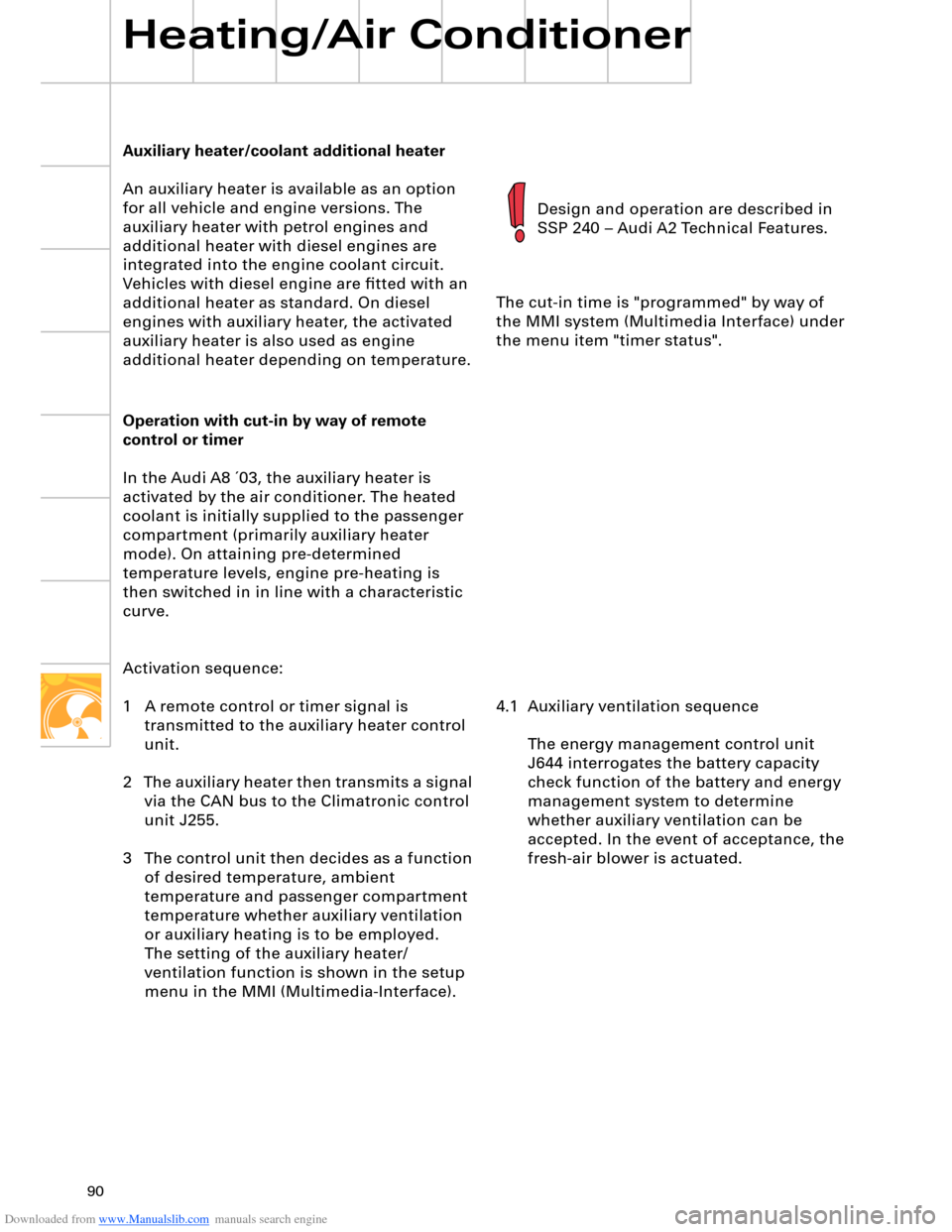
Downloaded from www.Manualslib.com manuals search engine 90
Auxiliary heater/coolant additional heater
An auxiliary heater is available as an option
for all vehicle and engine versions. The
auxiliary heater with petrol engines and
additional heater with diesel engines are
integrated into the engine coolant circuit.
Vehicles with diesel engine are fitted with an
additional heater as standard. On diesel
engines with auxiliary heater, the activated
auxiliary heater is also used as engine
additional heater depending on temperature.
Heating/Air Conditioner
Design and operation are described in
SSP 240 – Audi A2 Technical Features.
Operation with cut-in by way of remote
control or timer
In the Audi A8 ´03, the auxiliary heater is
activated by the air conditioner. The heated
coolant is initially supplied to the passenger
compartment (primarily auxiliary heater
mode). On attaining pre-determined
temperature levels, engine pre-heating is
then switched in in line with a characteristic
curve.
Activation sequence:
1 A remote control or timer signal is
transmitted to the auxiliary heater control
unit.
2 The auxiliary heater then transmits a signal
via the CAN bus to the Climatronic control
unit J255.
3 The control unit then decides as a function
of desired temperature, ambient
temperature and passenger compartment
temperature whether auxiliary ventilation
or auxiliary heating is to be employed.
The setting of the auxiliary heater/
ventilation function is shown in the setup
menu in the MMI (Multimedia-Interface).The cut-in time is "programmed" by way of
the MMI system (Multimedia Interface) under
the menu item "timer status".
4.1 Auxiliary ventilation sequence
The energy management control unit
J644 interrogates the battery capacity
check function of the battery and energy
management system to determine
whether auxiliary ventilation can be
accepted. In the event of acceptance, the
fresh-air blower is actuated.